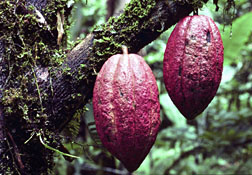Cacao traces found on two pieces of Mayan pottery in Mexico suggest pre-Hispanic culture may have added chocolate-flavored sauce to food like Molé.
A joint research project between Mexico’s National Institute of Anthropology and History (INAH) and Millsaps College, Mississippi, revealed a specific ratio of theobromine and caffeine compounds typical of cacao in the residue.
The artifacts were found at the Paso del Macho site in the Yucatan, and one of the fragments appears to be a serving plate. Dating of the residue places it between 600 and 500 B.C.
Previous evidence of cacao use has only been associated with drinking vessels, mostly in other parts of Central America, up to about 1,000 years older than the new findings.
“One of the pottery shards that has been identified as having had cacao residue was not a bowl or jar, as is typical, but a plate,” said chemist Timothy J. Ward at Millsaps College in a press release.
“This raises the possibility that cacao was not only being used to prepare a beverage at this early time, but was already being used in sauces for dishes, perhaps similar to the popular dish known as Molé.”
Archaeologist Thomas Gallareta Negron at INAH believes the beans were not crushed on the plate because metates or grinding stones were generally used for that purpose.
Paso del Macho was a small settlement, but was probably important because it had several mounds and a ball court. The chocolate may only have been used by upper classes and priests.
“This evidence combined with other archaeological, architectural, and settlement data, is providing us with a new view of this little known area of the Maya world during the earliest times,” said Gallareta Negron in the release.
“The Northern Maya world was just as complex and sophisticated as the far better-known Southern Maya area, and we can now add the consumption of cacao to this list of traits.”
The Epoch Times publishes in 35 countries and in 19 languages. Subscribe to our e-newsletter.






